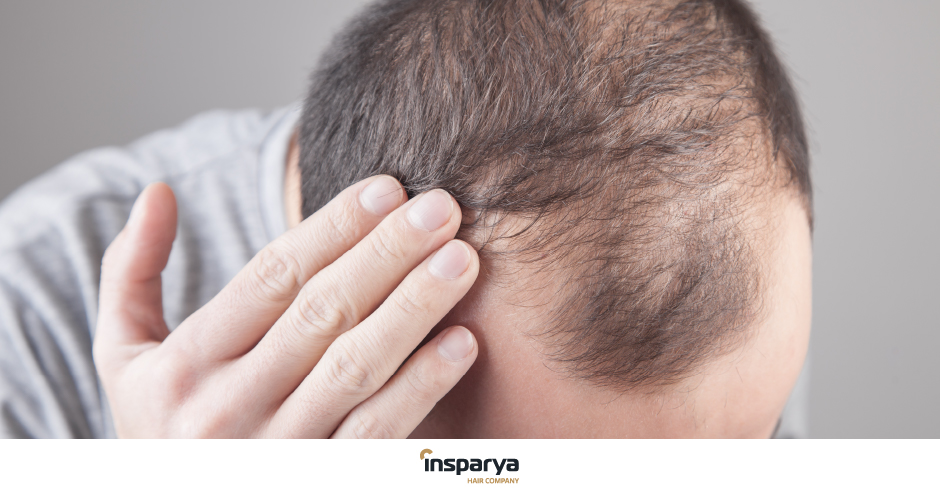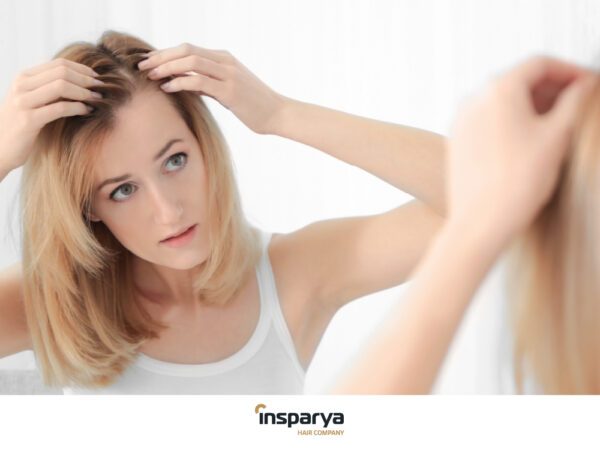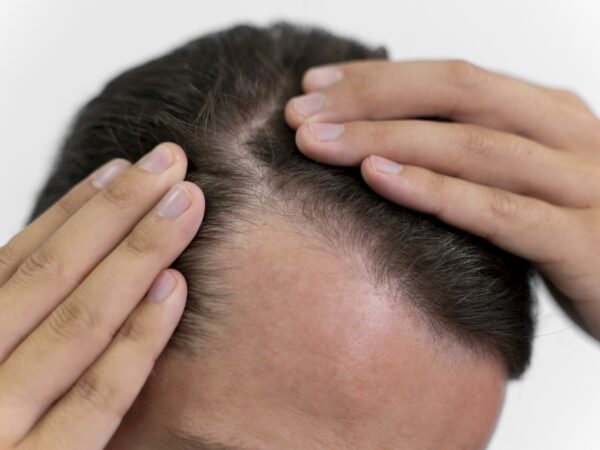
Minoxidil: what it is for and its side effects
- What is Minoxidil?
- How should this medicine be used?
- What is Minoxidil used for?
- How does Minoxidil work?
- In what cases can it be used?
- Do the results last?
- How long does it take for Minoxidil to take effect?
- Who can use Minoxidil to stop hair loss?
- What side effects does Minoxidil have?
- Is Minoxidil better than a hair transplant?
- What special precautions should I follow?
- Minoxidil reviews
People have been looking for solutions to the disease of alopecia throughout history, from home treatments to the most advanced medications and treatments, such as hair transplants with the FUE technique. Baldness is undoubtedly a common concern, as is the most common form of alopecia – androgenic alopecia, which up to 80% of the male population in Spain experience at some point in their lives.
Keep reading to find out more about one of the most well-known pharmacological treatments to fight androgenic alopecia in both men and women: Minoxidil.
What is Minoxidil?
It is a vasodilator initially used to combat high blood pressure. Though it was found not to be very effective for this purpose, a major side effect was seen: the strengthening of existing hair and the stimulation of new hair growth. This is how research on it began; it was concluded that, in some cases, Minoxidil is helpful for improving hair health.

How should this medicine be used?
If your specialist has prescribed a treatment with Minoxidil, applied either topically or orally, you should follow their guidelines to get the best results. Keep in mind that being consistent is very important: interrupted treatment can lead to lower hair density and a halt in the production of new hair. In addition, proper application of topical treatments is key to achieving optimal results.
What is Minoxidil used for?
Its main function is to maintain and strengthen hair, not restore it. There is only one solution for restoring hair: a hair transplant.
When facing problems with alopecia, it is always advisable to consult with a specialist who will identify the causes and prescribe appropriate treatment. Depending on the type and degree of alopecia, we can use drugs like Minoxidil, or even Finasteride or Dutastaride, in addition to hair treatments like hair mesotherapy, Platelet-Rich Plasma (PRP) or low-frequency laser. Moreover, combining these treatments improves their effectiveness because they complement each other.
How does Minoxidil work?
As we said before, Minoxidil has a vasodilating effect, so it encourages blood flow to follicles. This makes hair grow stronger.
In what cases can it be used?
It is most effective in the early stages of hair loss and for people under 40 who have recently started to lose hair. Don’t forget, if you’re already experiencing baldness, Minoxidil will not help repopulate hairless areas or prevent a receding hairline from becoming more pronounced. The specialist will always be the one to determine when this type of treatment is suitable.
Do the results last?
Once you start taking Minoxidil, you should assume that treatment will be ongoing to maintain the results. If you stop, you will be back to where you started after 3 or 4 months. That’s why you should commit to your treatment and consider it to be just another part of your daily care routine.
How long does it take for Minoxidil to take effect?
You will start to see changes after 5-6 months, as long as you follow your doctor’s guidelines. Keep in mind that intense hair loss may occur in an initial phase, but you shouldn’t worry. Don’t stop treatment because of this since this partial loss is part of the process.

Who can use Minoxidil to stop hair loss?
Anyone who suffers from androgenetic alopecia in an early stage, especially if they are under 40. For men, 5% Minoxidil is advised; 2% is recommended for women. It is not recommended during pregnancy or breastfeeding, and it only helps with alopecia that has hormonal and genetic causes. That means it isn’t helpful for cicatricial alopecia, for example.
What side effects does Minoxidil have?
- Headache due to vasodilation.
- In some cases, hypertrichosis, which involves the appearance of hair in hormone-dependent areas, especially among women (sideburns, chin) and also among men (beard, arms).
- Infrequent cardiovascular problems.
- When applied topically, an increase in seborrhea, local sensitivity (with significant redness), and dermatitis can occur.
Don’t forget to follow your doctor’s recommendations; applying or ingesting more Minoxidil than indicated will not provide faster results. It can, however, increase the chances of adverse effects.
If you experience dizziness, chest pain, heart rate acceleration, breathing difficulties, inflammation in any part of your body, weight gain, irritation, or itching or burning on the scalp that does not go away and is intense, check with your doctor as soon as possible.
So, how good is Minoxidil? It is undoubtedly an effective option to slow down hair loss; its side effects are offset by the results.
Can Minoxidil make you bald?
The answer is no, Minoxidil does not cause alopecia. This myth about Minoxidil may have originated due to the shedding that occurs at the beginning of treatment. The reason for this loss is that the drug can accelerate hair loss by shortening the resting phase. But don’t be alarmed: this is totally normal and is part of the hair restoration process.
What happens if I stop using Minoxidil?
As we said before, you must commit to the treatment if you want lasting results. If you stop using it, you have to assume that you’ll go back to square one since you’ll lose all the benefits reaped for your hair while following the regimen.
How is Minoxidil applied?
There are two ways: topically, meaning directly on the scalp using a spray, roll-on, pipette, or syringe, or ingesting it in pill form.
For topical treatment, Minoxidil 5% should be used 2 times a day. Apply the appropriate amount to the affected area and spread the product with your fingers. Remember not to wash your hair until at least 4 hours after application, and don’t use the hairdryer if possible. Wash your hands thoroughly after applying it, and note that you may stain sheets a little.
Often, patients only use it at night because of the unpleasant aesthetic effect it has on the hair (as if it were excessively greasy). However, this reduces the therapeutic effect.
An oral dose will depend on gender, the type and pattern of alopecia, the patient’s other medical treatments, and their other particularities. That is, it should be a personalised treatment. As a reference, doses of 0.25 to 2 mg per day are common for women, and between 2.5 and 5 mg are recommended for men.
Is Minoxidil better than a hair transplant?
It is not better or worse. It does not do the same thing. Minoxidil absolutely cannot substitute for a hair transplant; it only maintains and strengthens hair. However, a transplant makes it possible to permanently recover lost hair in the areas affected by alopecia.
Thus, it can be a good complement to a transplant, which can also be combined with hair treatments like those mentioned above (mesotherapy, PRP, low-frequency laser). Your doctor will determine the option that is best for your situation.
If you are interested in possible alternatives to Minoxidil, you have likely searched for home remedies for alopecia. Popular culture, which dates back before many advances in research, has been trying to find solutions for baldness for centuries. There is actually no evidence that tricks like applying almond oil or green tea really help, though they may nourish hair in some cases. What we do know is positive for hair health is stimulating the scalp with gentle massages, using quality hair products, eating foods with biotin, and generally following a healthy diet. Under no circumstances will these measures stop alopecia, though.
When facing any hair problem, it is best to contact a specialised team such as Insparya; they will evaluate your hair health in detail to determine which treatment is most appropriate.
Pros and cons of Minoxidil – Insparya
What special precautions should I follow?
With topical Minoxidil, avoid contact with your eyes, nose, and mouth. Do not put anything else on the area where you apply it (bandages, dressings, lotions) unless your doctor tells you to. If you ingest it, do not worry about food absorption; this doesn’t interfere with its effects. Also remember that each treatment is tailored to the patient’s needs, so you shouldn’t share it.
If you notice any of the side effects described above, check with a doctor as soon as possible. You should also go to check-ups regularly for the specialist to make sure that everything is progressing as expected.
What should I do if I miss a dose?
Don’t take double doses to make up for forgetting one. Just take it or apply it when you remember. If it’s almost time for the second dose, then go ahead and take that one earlier, but don’t take two at once.
How should I store or dispose of this medicine?
Keep it in its tightly closed container, out of reach of children and away from heat and moisture. That means that the bathroom is not a good place for topical Minoxidil. If you want to dispose of it in either capsule or liquid form, take it to your pharmacy, where they will responsibly dispose of the medicine.
Minoxidil reviews
People who take a Minoxidil treatment usually point out that they have seen a significant change in their hair. This includes both men and women who consistently use it for more than 4 months of treatment. The improvement in density, thickness, and vitality are significant. Of course, some patients mention some redness on the scalp, stinging, or itching, especially if applied as a lotion. This is because it includes alcohol, which generates irritation and dryness. These complaints usually get better over time.
If you have more questions about Minoxidil or want to know if it is right for your situation, contact Insparya now. Our experts will take a look at your case and tell you which treatment is best to improve your hair health.




